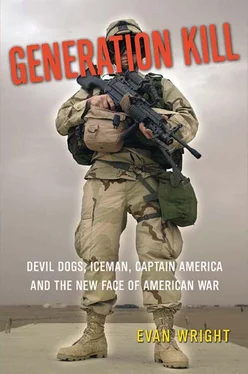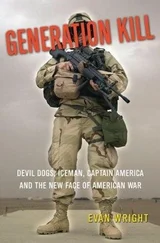It’s the first time anyone has seriously raised this possibility: that war is not fun, that it might, in fact, actually suck.
In the coming weeks, it will fall on the men in this platoon and their battalion to lead significant portions of the American invasion of Iraq. They belong to an elite unit, First Reconnaissance Battalion, which includes fewer than 380 Marines. Outfitted with lightly armored or open-top Humvees that resemble oversized dune buggies, they will race ahead of the much larger, better-equipped primary Marine forces in Iraq. Their mission will be to seek out enemy ambushes by literally driving into them.
Major General James Mattis, commander of the First Marine Division—the bulk of the Corps’ ground forces in Iraq—would later praise the young men of First Recon for being “critical to the success of the entire campaign.” While spearheading the American blitzkrieg in Iraq, they will often operate deep behind enemy lines and far beyond anything they have trained for. They will enter Baghdad as liberating heroes only to witness their astonishing victory crumble into chaos. They will face death every day. They will struggle with fear, confusion, questions over war crimes and leaders whose competence they don’t trust. Above all, they will kill a lot of people. A few of those deaths the men will no doubt think about and perhaps regret for the rest of their lives.
°
MAJOR GENERAL JAMES MATTIS calls the men in First Reconnaissance Battalion “cocky, obnoxious bastards.” Recon Marines belong to a distinct military occupational specialty, and there are only about a thousand of them in the entire Marine Corps. They think of themselves, as much as this is possible within the rigid hierarchy of the military, as individualists, as the Marine Corps’ cowboys. They evolved as jacks-of-all-trades, trained to move, observe, hunt and kill in any environment—land, sea or air. They are its special forces.
Recon Marines go through much of the same training as do Navy SEALs and Army Special Forces soldiers. They are physical prodigies who can run twelve miles loaded with 150-pound packs, then jump in the ocean and swim several more miles, still wearing their boots and fatigues, and carrying their weapons and packs. They are trained to parachute, scuba dive, snowshoe, mountain climb and rappel from helicopters. Fewer than 2 percent of all Marines who enter in the Corps are selected for Recon training, and of those chosen, more than half wash out. Even those who make it commonly only do so after suffering bodily injury that borders on the grievous, from shattered legs to broken backs.
Recon Marines are also put through Survival Evasion Resistance Escape school (SERE), a secretive training course where Marines, fighter pilots, Navy SEALs and other military personnel in high-risk jobs are held “captive” in a simulated prisoner-of-war camp in which the student inmates are locked in cages, beaten and subjected to psychological torture overseen by military psychiatrists—all with the intent of training them to stand up to enemy captivity. When Gunny Wynn went through SERE, his “captors,” playing on his Texas accent, forced him to wear a Ku Klux Klan hood for several days and pull one of his fellow “inmate” Marines, an African American, around on a leash, treating him as a slave. “They’ll think of anything to fuck you up in the head,” Gunny Wynn says.
Those who make it through Recon training in one piece, which takes several years to cycle all the way through, are by objective standards the best and toughest in the Marine Corps. Traditionally, their mission is highly specialized. Their training is geared toward stealth—sneaking behind enemy lines in teams of four to six men, observing positions and, above all, avoiding contact with hostile forces.
The one thing they are not trained for is to fight from Humvees, maneuvering in convoys, rushing headlong into enemy positions. This is exactly what they will be doing in Iraq. While the vast majority of the troops will reach Baghdad by swinging west onto modern superhighways and driving, largely unopposed, until they reach the outskirts of the Iraqi capital, Colbert’s team in First Recon will get there by fighting its way through some of the crummiest, most treacherous parts of Iraq, usually far ahead of all other American forces. By the end of the campaign, Marines will dub their unit “First Suicide Battalion.”
Mattis began hatching his plans for First Recon’s unorthodox mission back in November. The General is a small man in his mid-fifties who moves and speaks quickly, with a vowel-mashing speech impediment that gives him a sort of folksy charm. A bold thinker, Mattis’s favorite expression is “Doctrine is the last refuge of the unimaginative.” On the battlefield, his call sign is “Chaos.” His plan for the Marines in Iraq would hinge on disregarding sacred tenets of American military doctrine. His goal was not to shield his Marines from chaos, but to embrace it. No unit would embody this daring philosophy more than First Recon.
In the months leading up to the war on Iraq, battles over doctrine and tactics were still raging within the military. The struggle was primarily between the more cautious “Clinton generals” in the Army, who advocated a methodical invasion with a robust force of several hundred thousand, and Secretary of Defense Donald Rumsfeld and his acolytes, who argued for unleashing a sort of American blitzkrieg on Iraq, using a much smaller invasion force—one that would rely on speed and mobility more than on firepower. Rumsfeld’s interest in “maneuver warfare,” as the doctrine that emphasizes mobility over firepower is called, predated invasion planning for Iraq. Ever since becoming Secretary of Defense, Rumsfeld had been pushing his vision of a stripped-down, more mobile military force on the Pentagon as part of a sweeping transformation plan.
Mattis and the Marine Corps had been moving in that direction for nearly a decade. The Iraq campaign would showcase the Corps’ embrace of maneuver warfare. Mattis envisioned the Marines’ role in Iraq as a rush. While the U.S. Army—all-powerful, slow-moving and cautious—planned its methodical, logistically robust movement up a broad, desert highway, Mattis prepared the Marines for an entirely different campaign. After seizing southern oil facilities within the first forty-eight hours of the war, Mattis planned to immediately send First Recon and a force of some 6,000 Marines into a violent assault through Iraq’s Fertile Crescent. Their mission would be to seize the most treacherous route to Baghdad—the roughly 185-kilometer-long, canal-laced urban and agricultural corridor from Nasiriyah to Al Kut.
Saddam had viewed this route, with its almost impenetrable terrain of canals, villages, rickety bridges, hidden tar swamps and dense groves of palm trees, as his not-so-secret weapon in bogging down the Americans. Thousands of Saddam loyalists, both Iraqi regulars and foreign jihadi warriors from Syria, Egypt and Palestinian refugee camps, would hunker down in towns and ambush points along the route. They had excavated thousands of bunkers along the main roads, sown mines and propositioned tens of thousands of weapons. When Saddam famously promised to sink the American invaders into a “quagmire,” he was probably thinking of the road from Nasiriyah to Al Kut. It was the worst place in Iraq to send an invading army.
Mattis planned to subvert the quagmire strategy Saddam had planned there by throwing out a basic element of military doctrine: His Marines would assault through the planned route and continue moving without pausing to establish rear security. According to conventional wisdom, invading armies take great pains to secure supply lines to their rear, or they perish. In Mattis’s plan, the Marines would never stop charging.
Читать дальше












